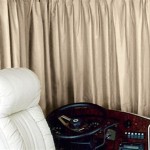Do not write a conclusion.
Ceiling Curtains For Living Room: A Comprehensive Guide
Ceiling curtains, also known as ceiling-mounted curtains or track curtains, offer a unique and sophisticated approach to window treatments and space division within a living room. Unlike traditional curtain installations that rely on rods attached to the wall above the window frame, ceiling curtains are suspended from tracks directly affixed to the ceiling. This design element creates a seamless and visually expansive effect, enhancing the overall aesthetics and functionality of the living space.
The choice of ceiling curtains can significantly impact the ambiance, privacy, and light control within a room. By understanding the various aspects of these installations, homeowners and interior designers can make informed decisions that align with their specific needs and design preferences. This article provides a comprehensive overview of ceiling curtains for living rooms, covering key considerations such as types, benefits, installation, and style selection.
Types of Ceiling Curtain Tracks
The effectiveness and aesthetic appeal of ceiling curtains heavily rely on the type of track system employed. Several options are available, each offering specific advantages in terms of functionality, durability, and visual integration with the surrounding décor. Understanding the differences is crucial for selecting the most appropriate track for a given living room setup.
Straight Tracks: These are the most common and straightforward type of ceiling curtain tracks. They are ideal for windows that are rectangular or linear in shape. Straight tracks provide smooth and efficient curtain movement along a defined path. They are typically constructed from aluminum or steel, ensuring durability and resistance to bending or warping. Straight tracks are available in various lengths and can be easily cut to size to fit the specific dimensions of the window or space being covered.
Curved Tracks: Curved tracks offer a more flexible solution for windows that are not perfectly straight or for creating unique design features. They can be used to follow the contours of bay windows, archways, or irregularly shaped walls. The curved design allows curtains to smoothly transition around corners, providing a seamless and visually appealing effect. The installation of curved tracks often requires more precision and expertise compared to straight tracks, as they need to be accurately aligned and secured to the ceiling to ensure proper curtain movement.
Flexible Tracks: Flexible tracks, typically made from PVC or similar pliable materials, are highly adaptable and can be bent or shaped to fit virtually any configuration. This type of track is particularly useful for creating room dividers or for unusual window shapes where rigid tracks would be impractical. Flexible tracks are generally easier to install than curved tracks, as they can be adjusted and molded to the desired shape on-site. However, they may not offer the same level of durability and load-bearing capacity as metal tracks.
Motorized Tracks: Motorized curtain tracks provide the ultimate in convenience and functionality. These systems allow users to open and close the curtains with the touch of a button, using a remote control, or even via smartphone integration. Motorized tracks are especially beneficial for large or hard-to-reach windows. They offer enhanced security and privacy by allowing automated curtain operation, even when the homeowner is away. While motorized tracks are more expensive than manual systems, they offer a significant upgrade in terms of user experience and convenience. Installation typically requires professional expertise to ensure proper wiring and programming of the motor.
Benefits of Using Ceiling Curtains in a Living Room
Ceiling curtains offer several advantages over traditional window treatments, contributing to both the aesthetic appeal and functional performance of the living room. These benefits extend beyond simple window coverings, influencing the overall atmosphere and usability of the space.
Enhanced Vertical Space: By mounting the curtains directly to the ceiling, they create the illusion of greater height in the room. This effect is particularly beneficial in rooms with low ceilings, as it visually elongates the walls and makes the space feel more open and airy. The uninterrupted vertical line from the ceiling to the floor draws the eye upwards, creating a sense of grandeur and spaciousness. This is a key advantage for smaller living rooms where maximizing the perception of space is crucial.
Seamless and Modern Aesthetic: Ceiling curtains offer a clean and contemporary look that integrates seamlessly with modern interior design styles. The absence of visible curtain rods and brackets contributes to a minimalist aesthetic, allowing the focus to remain on the fabric and the overall design of the room. This streamlined appearance can enhance the sophistication of the living room, creating a cohesive and visually appealing environment. The sleek design of ceiling tracks complements modern furnishings and architectural elements, contributing to a polished and refined look.
Improved Light Control and Privacy: Ceiling curtains provide superior light control and privacy compared to traditional curtains. The close proximity of the fabric to the ceiling minimizes light gaps at the top of the window, effectively blocking out unwanted sunlight or glare. This is particularly important for homeowners who want to create a dark and cozy atmosphere for movie nights or for those who need to reduce glare on electronic devices. Similarly, ceiling curtains offer enhanced privacy by completely covering the window opening, preventing outsiders from seeing into the room. The ability to precisely control light and privacy levels contributes to the overall comfort and functionality of the living room.
Versatile Room Division: Ceiling curtains can be used as effective room dividers, creating flexible and adaptable living spaces. This is particularly useful in open-plan living rooms where different areas need to be temporarily separated for specific purposes. For example, a ceiling curtain can be used to create a cozy reading nook, a temporary guest bedroom, or a designated play area for children. When not needed, the curtains can be easily drawn back, restoring the open flow of the room. This versatility makes ceiling curtains an ideal solution for homeowners who want to maximize the functionality of their living space.
Installation Considerations for Ceiling Curtains
Proper installation is crucial for the successful implementation of ceiling curtains. A well-executed installation ensures that the curtains function smoothly, look aesthetically pleasing, and are securely attached to the ceiling. Several factors need to be considered during the installation process to ensure optimal results.
Ceiling Type and Structural Integrity: The type of ceiling construction is a primary consideration when installing ceiling curtains. Different materials, such as drywall, plaster, or concrete, require different types of mounting hardware and techniques. It is essential to determine the structural integrity of the ceiling before proceeding with the installation. For drywall ceilings, it is important to locate the ceiling joists or studs to provide a secure anchor for the track. Using drywall anchors alone may not be sufficient to support the weight of the curtains. For concrete ceilings, specialized drill bits and anchors are required to ensure a solid and reliable attachment. Consulting with a professional installer is recommended, especially for complex ceiling structures, to ensure that the installation is safe and secure.
Track Placement and Alignment: Accurate track placement and alignment are critical for smooth curtain movement and a visually appealing result. The track should be positioned precisely above the window or the desired area being covered. Proper alignment ensures that the curtains hang straight and that the fabric does not bunch or snag during operation. Using a level and measuring tape is essential for achieving accurate track placement. It is also important to consider the distance between the track and the wall to allow sufficient space for the curtains to hang freely without rubbing against the wall. Careful attention to detail during the track placement process will ensure a professional and functional installation.
Curtain Height and Length: Determining the appropriate curtain height and length is essential for achieving the desired aesthetic effect. Generally, curtains should extend from the ceiling to the floor, creating a seamless and elegant look. Measuring the distance from the ceiling to the floor is crucial for ordering the correct length of curtains. However, it is important to consider the type of fabric being used, as some fabrics may shrink or stretch after washing. Adding a few extra inches to the length can allow for adjustments after the curtains have been laundered. The height of the track above the window can also influence the perceived height of the room, so careful consideration should be given to this aspect during the planning stages. The optimal curtain height and length will depend on the specific design goals and the characteristics of the living room space.
Professional Installation vs. DIY: While it is possible to install ceiling curtains as a DIY project, professional installation offers several advantages. Professional installers have the expertise and experience to properly assess the ceiling structure, select the appropriate mounting hardware, and ensure that the track is securely and accurately installed. They also have the tools and equipment necessary to handle challenging installation scenarios, such as curved ceilings or complex wiring for motorized tracks. While professional installation may incur additional costs, it can save time, effort, and potential mistakes that could compromise the safety and functionality of the installation. Homeowners should carefully weigh the pros and cons of DIY versus professional installation before making a decision. For complex installations or for those with limited DIY experience, professional installation is highly recommended.

High Ceiling Curtains 2 Story Extra Long Living Room Cotton Blend Drapery Panels Bedroom Custom Made Etsy

100 Blackout Extra Long Linen Curtains Custom Made 9 24 Feet Length Wide 2 Story Living Room Ikiriska Off White Gray Tall Ceiling Drapes Etsy

Three Decorating Trends You Need To Be Warned About

10 Living Room Curtain Decor Ideas Curtains That Wow

Pinch Pleat 108 Inch Linen Curtains For Living Room 2 Panels Extra Long Natural Blend Semi Sheer Window Curtain Drapes Ceiling To Floor Large

Ceiling Mounted Curtain Tracks Open Up Possibilities

Floor To Ceiling Extra Long Curtains Tips Ideas The White Window

How To Choose Living Room Curtains Drapes And Shades Custom Window Designs Fort Lauderdale Fl

Luxury Bedroom Curtains Hotel Blackout Light Living Room Drapes Floor To Ceiling Window Curtain Thickened Soundproof Full

Extra Long 20 Ft Blackout Curtain Antique Bronze Grommet Tall For High Ceiling Or Window 2 Story Living Room 1 Panel 52
See Also








